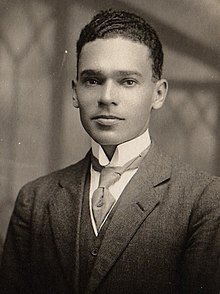William Robinson Clarke
William Robinson Clarke | |
|---|---|
 Clarke, c. 1914 | |
| Nickname(s) | Robbie |
| Born | 4 October 1895 Kingston, Jamaica |
| Died | 26 April 1981 (aged 88) Kingston, Jamaica |
| Buried | Military Cemetery at Up Park Camp, Kingston, Jamaica |
| Allegiance | United Kingdom |
| Service/ | Royal Flying Corps |
| Years of service | 1915–1919 |
| Rank | Sergeant |
| Unit | No. 4 Squadron RAF No. 254 Squadron RAF |
| Battles/wars | World War I |
| Awards | Silver War Badge |
| Other work | Builder |
Sergeant William Robinson Clarke (4 October 1895 – 26 April 1981) was a Jamaican World War I airman who was the first black pilot to fly for Britain.[1][2]
Early life[]
Clarke was born in Kingston, Jamaica, on 4 October 1895, son of Eugenia Clarke.[1] He became a mechanic, and was one of the first individuals in Jamaica to learn to drive.[3]
World War I[]
On the outbreak of war in 1914 Clarke, aged 19, travelled to England at his own cost.[4] He joined the Royal Flying Corps on 26 July 1915. He served initially as a mechanic and then as a driver for an observation balloon company.
In December 1916 he began pilot training, gaining his wings on 26 April 1917. He was posted to No. 4 Squadron RFC at Abeele on 27 May 1917, flying R.E.8 biplanes over the Western Front. In common with many pilots of the era his operational service was brief. On the morning of 28 July 1917, on a reconnaissance mission over Ypres, five miles on the German side of the lines, Clarke and his observer, Second Lieutenant F. P. Blencowe, were attacked by German scouts. He was seriously wounded and lost consciousness. The observer brought the aeroplane back to the British lines but crashed on making a forced landing near Godewaersvelde.[1]
In a letter to his mother, Clarke wrote: "I was doing some photographs a few miles the other side when about five Hun scouts came down upon me, and before I could get away, I got a bullet through the spine. I managed to pilot the machine nearly back to the aerodrome, but had to put her down as I was too weak to fly any more … My observer escaped without any injury."[3]
Sergeant Clarke recovered from his wounds and returned to duty as a mechanic with No. 254 Squadron in England. He was honourably discharged in 1919, receiving the Silver War Badge.[3]
Later life[]
After recovering from his wounds, Clarke returned to Jamaica. He was later active in the building trade. He was active in veterans affairs and was life president of the Jamaican branch of the Royal Air Forces Association.[4]
Commemoration[]
In 2021 the Imperial War Museum announced the acquisition of an identification bracelet belonging to Clarke into their collections.[5]
See also[]
- Eugene Bullard, was the first African-American military pilot, who flew for France.
- Ahmet Ali Çelikten of the Ottoman Empire.
References[]
- ^ a b c "Lives of the First World War". livesofthefirstworldwar.org. Retrieved 28 August 2017.
- ^ "RAF - News by Date". www.raf.mod.uk.
- ^ a b c "Robbie Clarke: Britain's First Black Pilot | Blog | RAF Museum". Royal Air Force Museum. Retrieved 28 August 2017.
- ^ a b "Unsung pilots of the Caribbean", Express & Star, 10 October 2014.
- ^ "Black RFC pilot's ID bracelet". Militaria History. 29 October 2020. Retrieved 11 March 2021.
- 1895 births
- 1981 deaths
- People from Kingston, Jamaica
- Royal Air Force personnel of World War I
- British World War I pilots
- Royal Flying Corps soldiers
- British Army personnel of World War I
- Royal Air Force airmen
- Black aviators